17 Ways To Make Your Sourdough Less (or More) Sour
17 easy ways and tips for making your homemade sourdough bread less (or more) sour while still preserving its delicious tangy flavor.
I often get asked how to make sourdough less sour. Or if you are like some people, you might like your bread to have a more sour taste.
I personally like my bread with a balanced, not too sour taste. But I often get asked about making bread more sour. As in San Francisco extra sour sourdough bread.
In this blog post, I am describing some basic principles of sourdough. Knowing these, you can then easily manipulate the sourness of your sourdough bread to your liking.
This post contains affiliate links, which means I make a small commission at no extra cost to you. You can read my full disclosure.
What is sourdough?
Sourdough is a leavening agent. It consists of flour, water, lactic acid bacteria, and wild yeasts. This fermentation produces carbon dioxide that makes your bread rise. If you use sourdough in your bread recipes, your bread will be easier to digest, has a better aroma and flavor, and stays fresh and lasts longer.
Lactic acid bacteria feed on the simple and complex sugars of the flour. In doing so, they produce lactic acid and acetic acid, usually in a ratio of ⅔ to ⅓. The fermentation of the natural yeast produces small amounts of alcohol that are also converted to acetic acid. While lactic acid is milder with a more yogurt-like flavor, the acetic acid tastes more like vinegar.
If you don’t already have one, be sure to check the easiest way to make a sourdough starter. As a new baker, you might also like to learn about my no-discard sourdough maintenance method.
Here are the various ways in which you can influence your sourdough to make your bread either less sour or more sour:

1. The flour
The type of flour you use does influence the sourness of your bread.
If you like your sourdough bread to be less sour, use more or mostly white flour or all-purpose flour. The more whole-grain flour you use the more sour your bread will be.
Of course, you can mill your own flour which will be even better. This is the grain mill I recommend.
2. Rye flour
If you want your bread to be even more sour, add rye flour to your sourdough recipes. Knowing this, you can play with the types of flour and amount of whole grain to white flour until you achieve the flavor that you like.
3. Oat flour
Also, in my whole grain sourdough bread, I have found that adding some amount of oat flour makes it taste very mellow and less sour.

4. Fermentation Temperature
The fermentation temperature probably plays the most important role in sourdough baking. Warmer temperatures encourage lactic acid production making your bread less sour. Cooler temperatures (such as room temperature) on the other hand favor acetic acid production and make your sourdough more sour.
This means that you may have to adjust differently whether you’re baking in the summer or in the winter. Pro Tip: You can check out my review of the Sourhouse Goldi that keeps your sourdough starter at an ideal temperature.
If you place your bread dough in the refrigerator, you are “retarding” your dough and thus giving it an even more complex flavor.
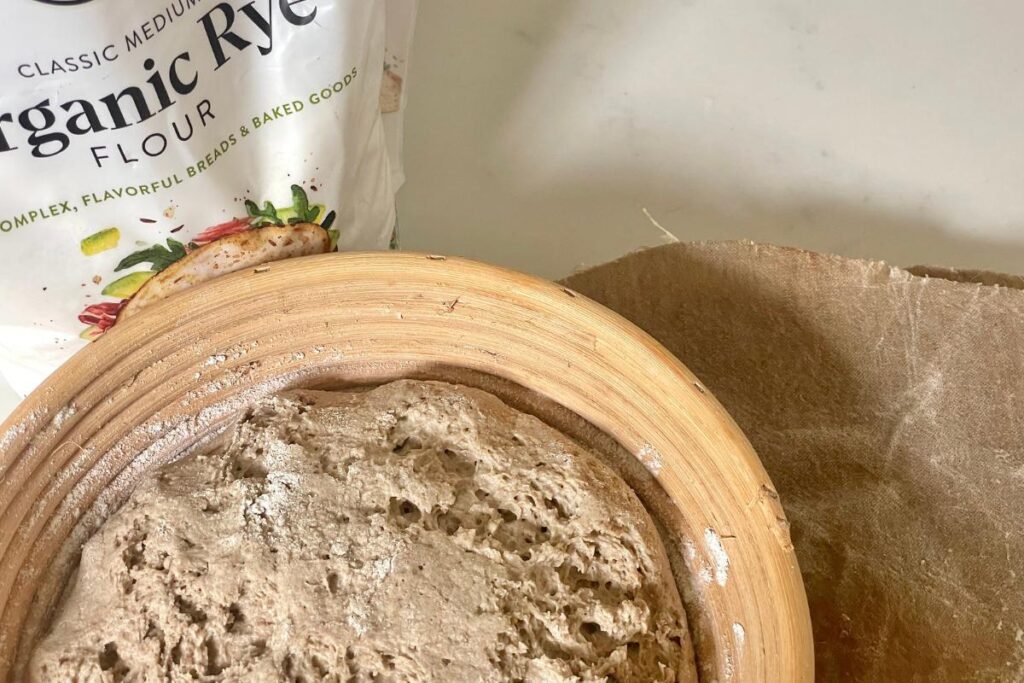
5. Water temperature
Playing with the temperature of the water that you add to your recipe is one of the best ways to affect the sourness. It is also easier to control than the ambient temperature.
If you like your bread to be less sour, use water at about 80˚F. If you like to increase the sourness, use warm water at about 90˚F to really get the yeasts and acid producers going.
6. Fermentation time
The temperature during the fermentation process also affects a more or less sour flavor.
The longer you let your dough rise, the more sour it will be while letting it rise for less time, makes it milder in flavor. This goes hand-in-hand with the fermentation temperature. The cooler the temperatures, the longer it takes, and the more sour your bread will be. Some people like to do the bulk fermentation in the refrigerator for 2-3 days.
7. The age of the sourdough culture
A fresh starter will produce milder bread while a more mature sourdough starter will create a more sour dough.
8. How often you use/feed your sourdough starter
If you feed or use your starter more often, it will be milder. If on the other hand, you leave your sourdough starter in the refrigerator for a long time, it will become more acetic and sour.
9. The hydration of your starter
To increase the sourness, use a stiff starter at a lower hydration but if you like your bread to be less sour, use a wetter starter.
10. The amount of sourdough starter you use
If you use a small amount of starter, it will make the bread more sour. Conversely, you can make your bread less sour if you use a bit more starter than in your sourdough bread recipe.
11. The type of starter
Many bakers like making and using a 100% rye starter. Rye flour will give you a very active that will make your bread rise better – and taste more sour.
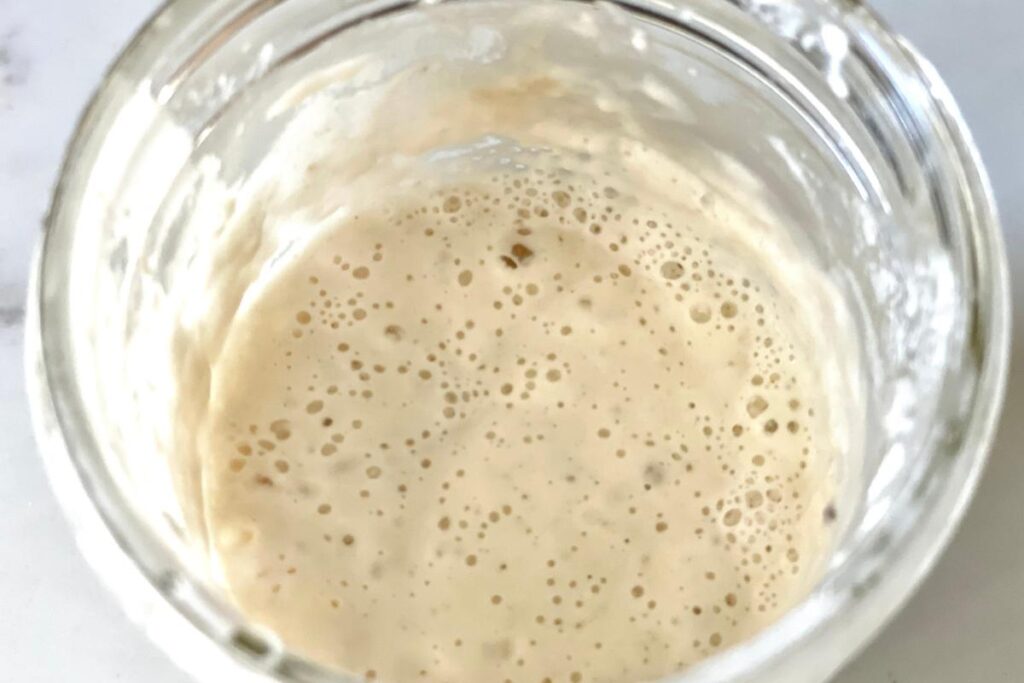
12. Sourdough starter feeding
This might get pretty scientific and very specific but this is another good way to affect the sourness of your bread.
Every sourdough culture will rise to a peak and then slowly deflate again. To experience this, it is a good idea for you to observe your sourdough culture to get a feeling for this cycle.
Feeding your sourdough starter before its peak will decrease the sourness of your bread while feeding your starter a few hours after it has peaked will make your final bread more sour.
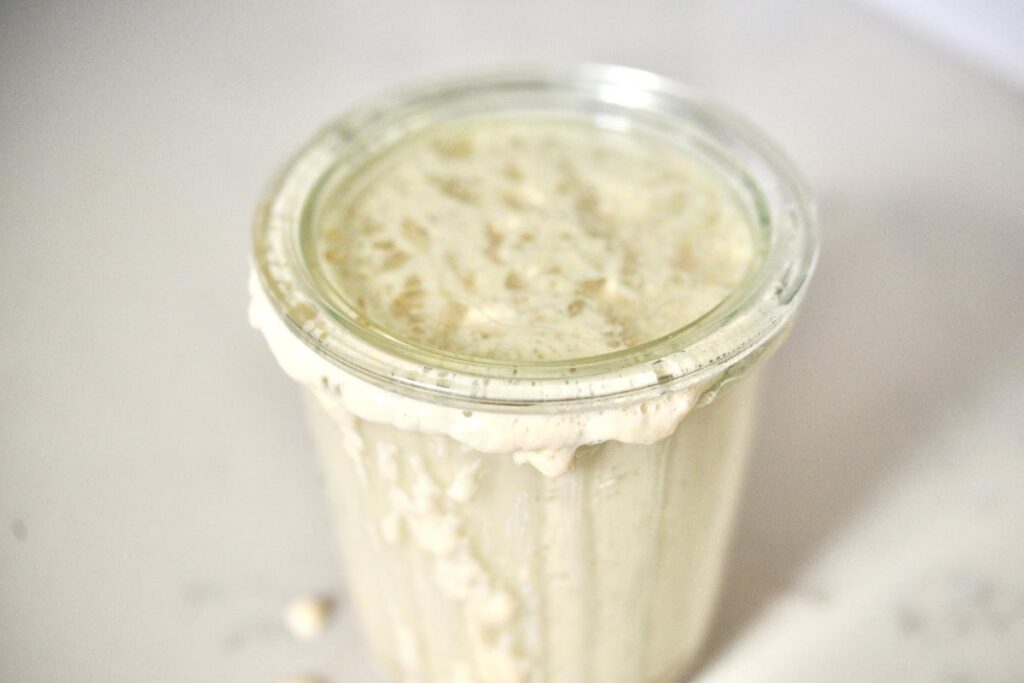
13. Oxygen
When I teach people how to make a sourdough starter, I will recommend that they stir it vigorously. This will add more oxygen to your starter which will also encourage the acetic acid bacteria thus making it more sour. For a less sour bread, I recommend you don’t go overboard here.
14. Prefermenting
Many sourdough bread recipes call for a preferment, leaven, mother culture, or levain. Essentially it is a mixture of some good starter, water, and fresh flour. You then let that sit for some time before adding the remaining ingredients. This preferment will do a few things:
It will really get your bread dough going and give it a good rise. But it will also make your final dough more acidic and sour.
15. Salt
Salt will slow down the fermentation of your dough and make it less sour. Typically, we add about 1-2% of salt to the dough. High-quality sea salt is always my choice. If you like a more sour bread, you can add just about 1% or a tad less salt to your dough.
16. Adding milk or fats
What else you put in your dough, can also affect the sourness. A simple sourdough bread recipe only calls for flour, water, salt, and a starter which will give it its unique flavor.
If you wanted a milder bread, you could add additional ingredients such as butter or milk. Adding olive oil will give you a softer dough structure and softer crust. Sourdough foccacia is a good example of a recipe where that is actually a desired outcome.
17. Adding baking soda
Adding a pinch of baking soda makes your coffee less acidic. Likewise, it makes sense that adding a bit of baking soda to your bread dough will also decrease the sourness of the final bread. As an added benefit, it will help make your dough rise more (check out my sourdough soda bread recipe).
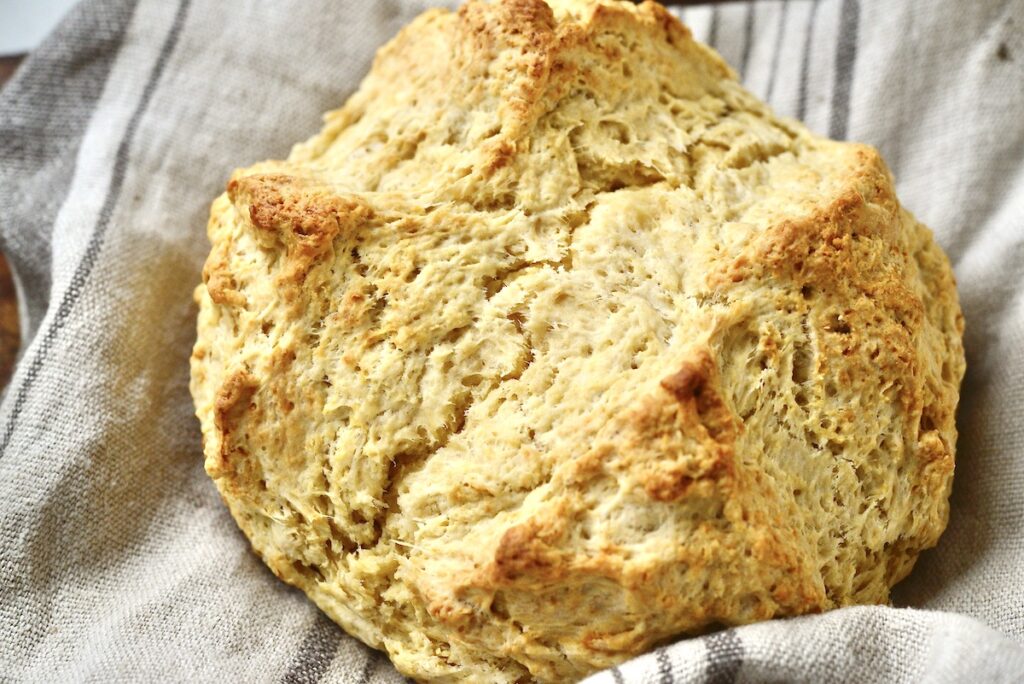
What about San Francisco sourdough?
San Francisco is famous for its often very sour sourdough bread. Every sourdough bread contains over 180 different species of lactic acid bacteria (source). The most common one is Lactobacillus sanfranciscensis and it was first identified in San Francisco sourdough. It grows particularly well in that Northern Californian city climate but pretty much exists in sourdough all over the world.
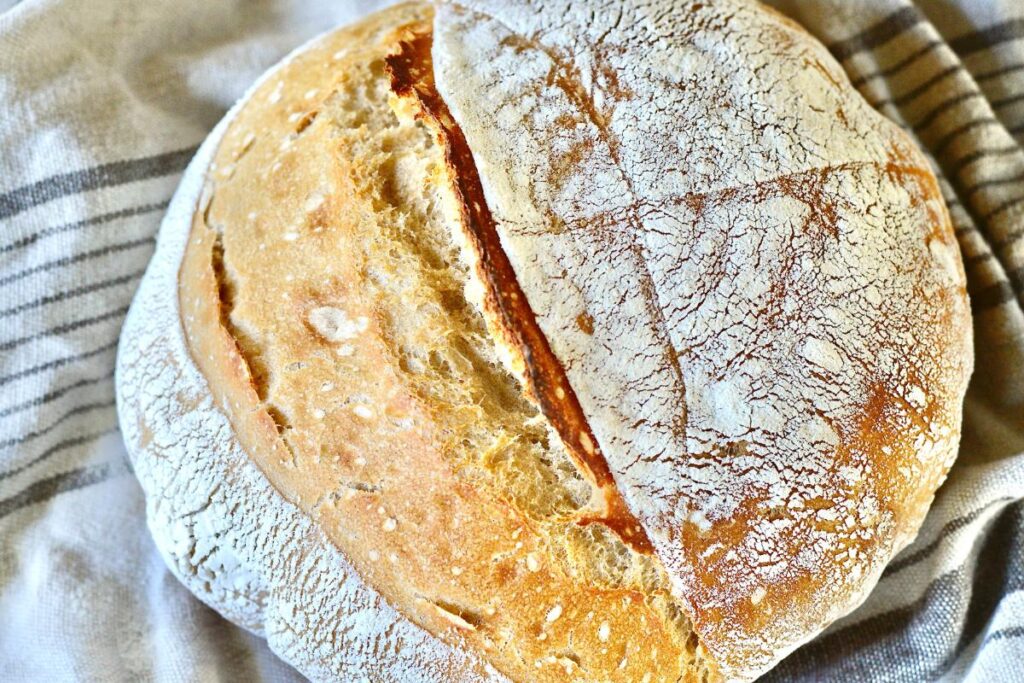
Other sourdough posts you might enjoy
How to Make a Sourdough Starter From Scratch
Easy Way to Maintain Your Sourdough Starter
How To Keep Your Sourdough Bread Fresh
9 Sourdough Secrets People Don’t Talk About
How To Convert Any Recipe to Sourdough
Pin For Later:
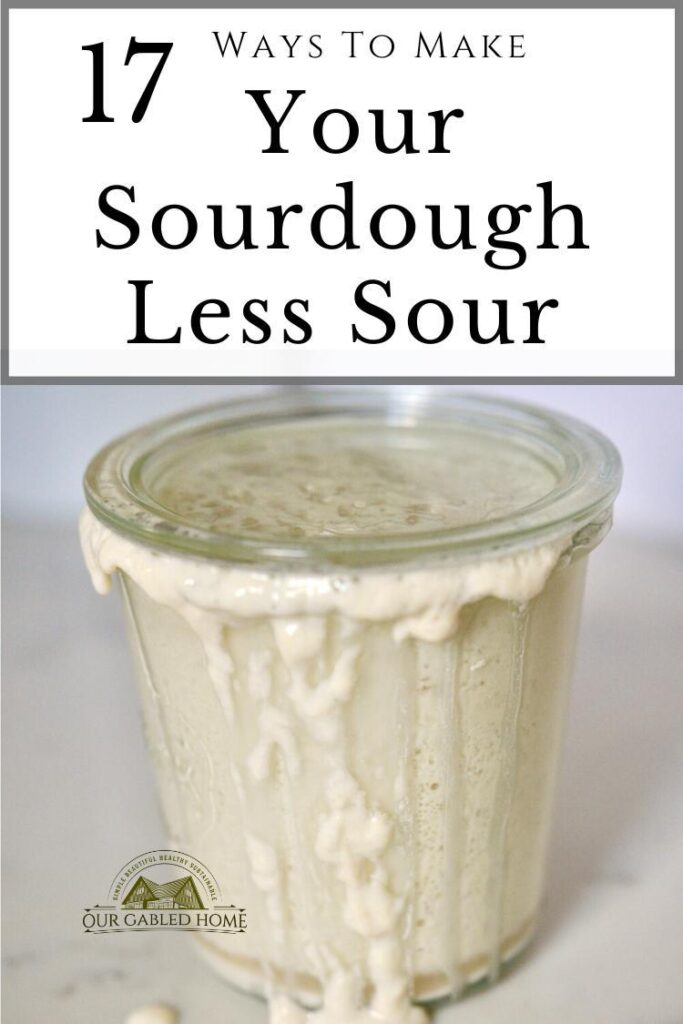

I have tried EVERY suggestion on many many sites to achieve a sour taste in my sourdough bread. Nothing has resulted in any sourness at all. Any further recommendations would be appreciated. PS email is correct
Unfortunately, I don’t know what else to recommend other than experimenting with adding some vinegar to the dough ~ Anja
Thank you very much for sharing your knowledge! I followed your recommendations for making the starter with an “eyeball” amount of flour, water and buttermilk, and in 2 days I had ripe bubbly starter! That same day I made 2 loaves of sourdough bread and they turned out perfectly! I wanted my sourdough a bit more tangy so I’m back, checking out your recommendations again. Thank you so very much for UNCOMPLICATING sourdough bread 😋
Yay! That makes me so happy to hear! Sourdough does not have to be complicated ~ Anja
I go a starter from King Arthur and it is very sour. Too sour for me.
You can use the concepts from this blog post to make it less sour – or make your own ~ Anja
Can full fat Greek yogurt be used in the place of buttermilk? What effect might that have on my starter?
If you’re using Greek yogurt, make sure it has live active cultures, and thin it down a bit with water (to buttermilk consistency) ~ Anja
Hi Anja. Thanks again for all the great info, now I have a question:
My starter smells like Blue Cheese…. 😀 Any thoughts on why? I love the smell, and the final loaf is great and, though it is quite sour, it doesn’t taste like Blue Cheese. I have not had Blue Cheese in that fridge since before I received my starter from a friend, and hers definitely did NOT smell like Blue Cheese…. she is a feed-and-discard-every-day person, while mine might sit in the fridge for close to two weeks before I need to make another loaf, which is usually the only time I feed it. Also, it did not start to smell like this until fairly recently, maybe two or three months ago, and I have had the starter for over a year.
I have two (just in case something happens) and I always use both every time I bake and refresh them the same. One is whole wheat, the other is white, but only the white one smells like Blue Cheese…. My bags of flour are all kept together in the same place. The starters are side-by-side in the fridge in mason jars with the lids screwed on.
Thank you!! 🙂
Your SD starter will react to your flour, your environment, you water, the ambient temperature, and so on. You can always take a small amount of your existing starter and add the same weight in water and flour to it, stir it, and let it sit for 4-8 hours to see if that changes the smell. Hope this helps ~ Anja
Started my starter today. Excited to see how it turns out in a week or so. Thanks for all the great info!
Sounds good and happy sourdoughing ~ Anja
Lots of good info in one place!
I am so glad to hear this ~ Anja
I have gave up on sourdough a few months ago. Maybe with these tips I will try to bake a sourgdough bread again. Thank you for sharing!
I so hope you’ll give sourdough another try! It’s so worth it ~ Anja
This is excellent info! I like mine SOUR!
Nice! Happy baking ~ Anja
Many thanks for all this great information Anja! My starter is spelt flour, but I do add both rye and white flours, a tad of honey as well. These warmer days the loafs rise so much quicker!
Yesterday was a bake day, and I made a loaf of bread, and a batch of your sourdough crackers. Yum!
Sounds great!! Thank you for sharing these tips ~ Anja